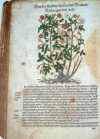Historical Contribution of Pharmaceutics to Botany and Pharmacognosy Development
- PMID: 29285002
- PMCID: PMC5723202
- DOI: 10.5455/msm.2017.29.291-300
Historical Contribution of Pharmaceutics to Botany and Pharmacognosy Development
Abstract
Introduction: Pharmacy and medicine belong to the oldest human activities, so the development of these sciences is closely related to the socio-economic, cultural and religious opportunities of the nations within which they have been developing.
Goals: To present the historical influence of pharmacy on the development of the human being from its very beginning; To present the historical link between pharmaceutical and medical activity, as well as early development of independent pharmaceutical activity; To present the historical influence of pharmacists on the development of botany and pharmacognosy and to present the historical influence of the first written herbarium and incunabula on the development of pharmacognosy.
Material and methods: The article has a descriptive character, and represents a systematic review of the literature dealing with this topic.
Results: The roots of pharmacy started to the very beginning of human civilization, when people collected various medicinal herbs and try to alleviate their health problems, pain and suffering. The scientific foundations of the pharmacy were set up in the antique period by the books of Dioskurides and Galen, and its further development continued in the mid-century, at the beginning by rewriting famous parts of ancient literature, and later by writing new discoveries (the base of this development was represented by South Italy) so that in 1240, for the first time in history, came the separation of doctors and pharmacists, and at the beginning of the 13th century the opening of the first pharmacy.
Conclusion: The effort to maintain knowledge of medicinal herbs and its practical application has led to the writing of a large number of recipes books, the forerunners of today's pharmacopeia, while the aspiration to classify medicinal herbs, and the desire to present medicinal herbs to ordinary people, has led to a large number of herbaria, making the knowledge and descriptions of plants available to many, not just the nobility. Descriptions of plants in herbaria and later in incunabula lead to the development of pharmacognosy, and to the opening of the first Department for pharmacognosy, 1545 in Padua.
Keywords: botany; pharmacognosy; pharmacy development.
Conflict of interest statement
• Conflict of interest: none declared.
Figures




Similar articles
-
Contribution of Arabic Medicine and Pharmacy to the Development of Health Care Protection in Bosnia and Herzegovina - the Second Part.Med Arch. 2017 Dec;71(6):439-448. doi: 10.5455/medarh.2017.71.439-448. Med Arch. 2017. PMID: 29416207 Free PMC article. Review.
-
[Mineral water as a cure].Veroff Schweiz Ges Gesch Pharm. 2008;29:13-402. Veroff Schweiz Ges Gesch Pharm. 2008. PMID: 19230311 German.
-
[Early achievements of the Danish pharmaceutical industry--8. Lundbeck].Theriaca. 2016;(43):9-61. Theriaca. 2016. PMID: 27491172 Danish.
-
[The origin of informed consent].Acta Otorhinolaryngol Ital. 2005 Oct;25(5):312-27. Acta Otorhinolaryngol Ital. 2005. PMID: 16602332 Italian.
-
[Introduction of "clinical pharmacognosy"--integration between pharmacognosy and clinical pharmacy].Yakugaku Zasshi. 2011 Mar;131(3):375-82. doi: 10.1248/yakushi.131.375. Yakugaku Zasshi. 2011. PMID: 21372533 Review. Japanese.
Cited by
-
Challenges and Opportunities behind the Use of Herbaria in Paleogenomics Studies.Plants (Basel). 2023 Sep 30;12(19):3452. doi: 10.3390/plants12193452. Plants (Basel). 2023. PMID: 37836192 Free PMC article. Review.
-
Transcriptome Profiling of Two Ornamental and Medicinal Papaver Herbs.Int J Mol Sci. 2018 Oct 16;19(10):3192. doi: 10.3390/ijms19103192. Int J Mol Sci. 2018. PMID: 30332811 Free PMC article.
-
Contribution of Arabic Medicine and Pharmacy to the Development of Health Care Protection in Bosnia and Herzegovina - the Second Part.Med Arch. 2017 Dec;71(6):439-448. doi: 10.5455/medarh.2017.71.439-448. Med Arch. 2017. PMID: 29416207 Free PMC article. Review.
References
-
- Mašić I. Srednjevjekovna arapska medicina/Medieval Arabic Medicine. Sarajevo: Avicena; 2010. p. 296. ISBN:978-9958-720-40-6.
-
- Ðuričić A, Elazar S. Pregled istorije farmacije Bosne i Hercegovine. Sarajevo: Centralni higijenski zavod; 1958.
-
- Grdinić V. Ilustrirana povijest farmakopeje. Zagreb: Medica; 2001.
-
- Kovačević N. Osnovi farmakognozije (treće izdanje) Institut za farmkognoziju Farmaceutski fakultet Univerzitet u Beogradu, Beograd. 2004
-
- Lukić P. Farmakognozija. Beograd: Farmaceutski fakultet Beograd; 1995.
Publication types
LinkOut - more resources
Full Text Sources
Other Literature Sources
